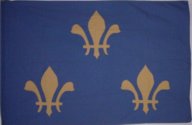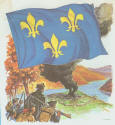 France
FranceFleur-de-Lis
Also known as the flag of Bourbon France.
Date: 1534 to 1700s.
Blue field with Gold fleur-de-lis. [R43]
Prior to the French Revolution, there was no national flag which represented France. From 1590-1790 the Fleur-de-Lis (flower of the lily) with a blue field was one of four that was used on warships and fortresses.
The most important flag carried by explorers and settlers was most likely this royal flag. In the early sixteenth century the French royal flag was blue with three gold fleurs-de-lis representing the shield in the royal French coat of arms. It is not likely that the French explorers Verrazano or Cartier actually raised this flag on land. At the time the practice of placing a permanent marker was preferred.
In the middle of the 17th century, France claimed sovereignty over all of Canada, the St. Lawrence, the Great Lakes country and the Mississippi River. The flag was used by Jacque Cartier in his explorations of the St. Lawrence. In the 1500s LaSalle, Joliet, and Champlain carried the royal emblems of France into the very heartland of the New World.
 In 1754, the French built
Fort Duquesne
at the Forks of Ohio to protect the lands they claimed to the west and
to force the English settlements back over the mountains. General John
Forbes's army entered the smoldering ruins of the evacuated Ft. Duquesne
on November 25, 1758, and the French were never to return to the valley
of La Belle Riviere.
In 1754, the French built
Fort Duquesne
at the Forks of Ohio to protect the lands they claimed to the west and
to force the English settlements back over the mountains. General John
Forbes's army entered the smoldering ruins of the evacuated Ft. Duquesne
on November 25, 1758, and the French were never to return to the valley
of La Belle Riviere.
During the French-Indian War, the French lost the Battle of Quebec. This left the British unchallenged from Canada to Georgia, except for the French city, New Orleans.
Louisiana was under French rule until 1803, but from 1794 the red-white-blue French Tri-color flag was used, the flag of the French Revolution.
Read more about the French military during the Revolution . . .